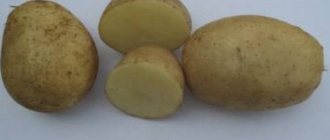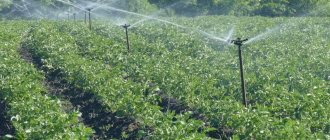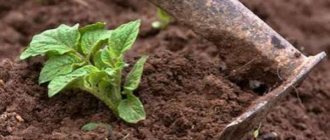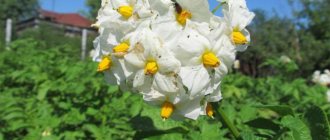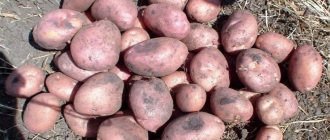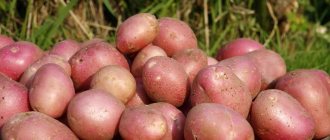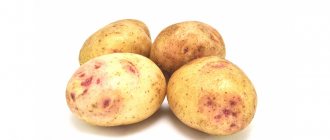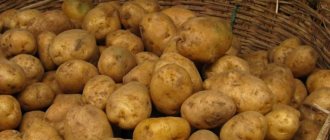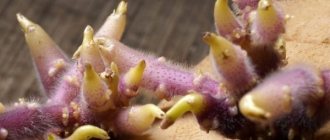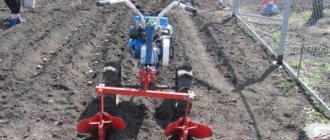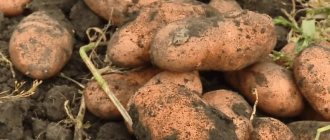Description of the variety
Early-ripening potatoes with a high shelf life have clear advantages over other types of this common vegetable.
Origin and development
The Red Sonya variety was bred by German breeders . In 2015, it was included in the State Register of Breeding Achievements of Russia.
Chemical composition, trace elements and vitamins
BJU content in 100 g of raw potatoes :
- proteins – 2 g;
- fats – 0.4 g;
- carbohydrates – 18 g.
The composition contains a full complex of amino acids . 100 g of potatoes contain 20 mg of ascorbic acid; during storage, the figure decreases to 30% of the original volume.
Other varieties of early ripening potatoes:
Drought Tolerant Red Lady Potatoes
Table potatoes "Uladar"
Frost-resistant potato variety "Rosalind"
Useful minerals:
- phosphorus;
- potassium;
- sodium;
- magnesium;
- zinc;
- cobalt.
One tuber contains from 0.8 to 1% ash, starch content - from 12 to 15%.
Ripening period
The growing season from full germination to ripening is 50-65 days . You can try the first tubers already on the 45th day.
Productivity
Red Sonya is a high-yielding variety . One bush produces up to 10 large fruits, the average yield is from 175 to 350 centners per hectare.
Disease resistance
The variety shows low susceptibility :
- to black spot virus;
- stem cancer;
- nematode;
- scab;
- late blight of tubers;
- black leg.
Potatoes are not affected by leaf curl .
Characteristics of tubers, description of appearance
The average weight of one fruit is from 120 to 200 g . The tubers are oval in shape and have a rich red skin with a smooth texture. The pulp is light yellow or yellow in color, does not become soft when cooked, the eyes are located on the surface, without creating problems during cleaning.
For which regions is it suitable, climate requirements?
According to the State Register, the variety is intended for planting in the North Caucasus and Volga-Vyatka regions. However, Red Sonya is not picky about soil and climatic conditions, so it is successfully cultivated in almost all regions of Russia. In the south it produces two harvests, and is successfully grown in other regions - provided that the plantings are properly cared for.
The main advantages and disadvantages of the variety
Positive qualities of the variety:
- early ripening;
- excellent taste and product characteristics;
- high productivity;
- a small number of eyes;
- excellent keeping quality;
- ease of transportation;
- resistance to pests and diseases;
- possibility of mechanical harvesting;
- undemanding to the growing region and soil.
The disadvantage is the mandatory germination of tubers to obtain an early harvest.
What is the difference from other varieties
Red Sonya differs from other types of potatoes:
- increased resistance to diseases and pests;
- early ripeness;
- almost complete absence of small tubers.
In addition, potatoes hardly become soft when cooked .
Diseases and pests
The Red Sonya variety is characterized by good resistance to the following diseases and pests:
- stem cancer;
- nematode;
- scab;
- blackleg;
- late blight of tubers;
- leaf curling;
- black spot virus.
However, to a small extent the plant is susceptible to late blight of tops and rhizoctonia.
To protect bushes from possible diseases, experienced gardeners recommend spraying in a timely manner and taking preventive measures. These include:
- soil cultivation;
- enriching it with essential minerals and trace elements;
- weed removal;
- loosening;
- correct agricultural technology.
During the growing season, the bushes are treated several times, combining foliar feeding with spraying. The tubers are suitable for food 3 weeks after the last spraying.
Features of planting and growing
Rich harvests are obtained only when ideal conditions are created . It is important not to plant potatoes after nightshade crops.
Preparing for landing
Before planting, the tubers are germinated:
- seed material is removed from storage 25-40 days before planting day;
- Defective, diseased, dried tubers are removed from the batch;
- each vegetable is washed with running water and disinfected in a solution of boric acid;
- dry in a dark, well-ventilated area;
- The tubers are heated for three days at a temperature of 25°C;
- laid out in wooden or plastic boxes with holes and placed in a bright place;
- Cover the top with gauze to prevent the potatoes from drying out.
For the active appearance of sprouts, the tubers are sprayed several times : with a weak solution of potassium permanganate, followed by an extract from ash. Germination is carried out at 18-20°C, then the temperature is lowered to 14°C. After a month, the sprouts should be 2 cm - if the desired size is not reached, add lighting.
Important! Two days before planting, the tubers are hardened. The boxes are covered with black cloth and sent to a room with a temperature of 12°C.
Soil requirements
The best harvests are obtained on loose, fertile soil enriched with mineral fertilizers. The soil must be moisture-absorbing; in dry and clayey soils, productivity decreases.
Before planting potatoes, the area is plowed and fertilized with manure, rotted humus, and bird droppings.
In the fall, the beds are sown with green manure, and in the spring they are plowed into the soil.
Agricultural technology
Before planting, the seed material must be germinated. Potatoes are planted in the ground when the average daily temperature is between 10-14 °C. During the period of active tuberization, it is necessary to pay special attention to watering. This way the potatoes will be uniform in weight, and the yield will increase significantly.
Flower bed design. TOP 10 simple and effective techniques
Seed tubers should not be too deep (5-8 cm). The distance between rows is 70-75 cm. Between bushes, a distance of 30-35 cm is considered ideal. Planting density is 430 per 100 sq.m.
Phosphorus-potassium and magnesium supplements are recommended. Does not require increased fertilization with nitrogenous compounds.
Nuances of care
Red Sonya potatoes require timely watering , fertilization, pest and disease control. Weeding and hilling play a big role in obtaining a large harvest.
Watering mode
Moistening is carried out as the soil dries . Timely watering will reduce the number of small tubers and increase the number of marketable potatoes. For high-quality soil moisture, it is recommended to use a drip system.
Top dressing
Additional fertilization is reflected in the weight of each tuber . If the land was well prepared before planting, then fertilizing is not needed throughout the growing season. If necessary, apply phosphorus-potassium fertilizers. It is not advisable to fertilize with nitrogen mixtures and fresh manure.
Fertilize according to the scheme:
- 2 weeks after planting potatoes;
- during the formation and growth of tubers;
- 21 days before harvest.
At the beginning of the growing season, potato bushes are fed with a solution of cow manure , which helps activate the growth of stems and leaves. Later, potash fertilizers are used, a mixture of “Superphosphate” and potassium sulfate. Before harvesting potatoes, a complex type of fertilizer is used, which subsequently allows you to extend the shelf life of the tubers.
Important! Urea and humates are suitable for periodic foliar feeding.
Weeding and hilling
Important agricultural techniques in growing potatoes are loosening the soil and removing weeds . Large tubers form better in loose soil. Loosening of compacted soil is carried out after each watering. Weeds are removed mechanically or manually.
Hilling up Red Sony is carried out according to the algorithm:
- after the shoots reach a size of 8-12 cm;
- 20-25 days after the first procedure;
- when the bush grows to 25 cm or more.
Repeat as necessary . If there is a strong growth of bushes and the tubers are visible on the surface, repeated hilling will be required. If this is not done, the potatoes will turn green and become unfit for consumption.
Disease and pest control
The main problem of the variety is damage by rhizoctonia . This disease responds well to treatment with Fitosporin.
The most dangerous pest is the Colorado potato beetle . Insecticides must be changed every year - the insect quickly adapts to any poison and becomes immune. For treatment, it is recommended to use the drugs “Euphoria” and “Connect”.
Potatoes Red Sonya
Not a single feast is complete without potato dishes. That's why so many gardeners grow it on their plots. The most important thing is to choose a good variety that is easy to care for and produces generous yields. Every year, breeders develop new and improved varieties with excellent characteristics. How to choose the right option for yourself? First of all, you need to familiarize yourself with the descriptions of different varieties, and only then determine the best option. Now we will look at the wonderful and unusual Red Sonya potato variety. It has many advantages that set it apart from other potatoes.
Harvest and storage
If the requirements for harvesting and maintenance conditions are met, Red Sonya gives good indicators for the shelf life of the crop.
How and when to collect
14 days before the scheduled harvest day, the tops are mown , which contributes to the formation of rough skin and dry eyes on the tubers. During this period, the potatoes finally ripen: such tubers are ideal for long-term storage.
Cleaning is scheduled on a sunny day so that the tubers have time to dry . Towards evening they are removed into the shade, where they are left for 2-3 days. Potatoes are harvested towards the end of August or at the very beginning of September. The exact schedule depends on the growing region.
Storage features and keeping quality of the variety
After digging, selection is carried out : diseased, damaged tubers are removed. Potatoes are sorted into marketable and non-commercial. The tubers are treated with drugs against fungal infections and dried in the shade for 2-3 weeks.
The prepared tubers are divided into small and large and placed in different containers . They are sent to storage at a temperature of +2...+4°C - they will not germinate there. Standard indoor humidity should be between 70 and 85%. If all conditions are met correctly, the potatoes will be stored for about 8 months.
Growing and care
Watering is carried out in the absence of precipitation. Soil moisture is checked at a depth of 10–15 cm. If necessary, water is poured into the grooves so that the ground is saturated with moisture to a depth of 45–50 cm. The liquid rate is from 20 to 45 liters per 1 sq. m. m. Maximum moisture is required at the height of flowering. Watering is stopped 1 month before digging. Drip systems are installed in large areas.
Fertilizers are applied according to the schedule:
| Deadlines | What is used |
| Beginning of growing season (12–15 days after germination) | Mullein or manure solution (1:15), Urea, Urea, Aquamix |
| Start of color burst | Novalon Foliar, Om, Superphosphate |
| The height of flowering | Mag-Boron, Potassium Sulfate, Superphosphate |
Hill up the bushes 2-3 times. The first time the procedure is carried out when the tops grow to 10 cm, then after 3 weeks. When the height of the bushes is 25–30 cm, they are hilled for the last time. The soil is poured over 2/3 of the length of the stems. In their work they use hillers, flat cutters, hoes, and cultivators.
The harvest is harvested in late June–early July. Seed material is immediately selected separately - a fraction of 40–50 mm is suitable. Dry in the shade and, if necessary, wash off the soil.
Advice from experienced gardeners and reviews about the Red Sonya variety
Experienced farmers advise to obtain large volumes of harvest :
- apply phosphorus fertilizers in an amount of 100 kg per hectare;
- feed with potassium at the rate of 200 kg per hectare;
- add magnesium in increased dosage.
Reviews about the variety are positive; its cultivation and storage does not cause difficulties for gardeners.
Svetlana, Sortavala : “I planted this variety for testing, fertilized it a couple of times, and watered it well. The potatoes grew large and quite tasty, and there was a good harvest. It was stored for 7 months, only a couple of spoiled tubers.”
Elena, Armavir : “For the last three years I have been planting only Red Sonya. I sell some, and keep some for myself. During drought, the tubers grow small - you need to periodically water and feed them. In my area, you can harvest two crops: first planted under film, and then in open ground. It stores well, I’m completely satisfied with the variety.”
Andrey, Syzran : “I was looking for potatoes with a long shelf life. I read the description of the Red Sonya variety, looked at the photo of the potato and settled on it. Surprisingly, the safety was almost 95%. I liked that I didn’t have to periodically go through all the tubers in the basement and pick off the sprouts.”
Reviews
Domestic buyers of the Red Sonya variety note the speed of ripening of its fruits. One and a half to two months, and you can harvest the crop and then plant a new one. Thus, many gardeners manage to get a double harvest in one season. In addition, the potatoes have a neat appearance and rich skin color. For many, this is a great option to sell. Most gardeners in their reviews claim that there are very few small things in the tubers, almost all potatoes are large and dense. The presence of small and shallow eyes allows you to comfortably peel vegetables for future culinary masterpieces. Gardeners also note the high taste of potatoes and their long shelf life.
For an overview of this potato variety, see the following video.
